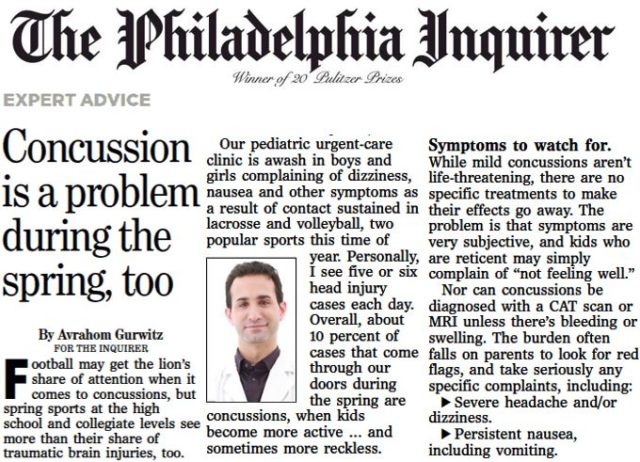Tap into Doctors’ Expertise to Build Thought Leadership Creds
When SPRYTE learned that a pediatrician at Holy Redeemer Hospital was seeing a spate of concussions relating to youth sports, we sprang into action to warn parents on signs they need to look for. The resulting article under Dr. Avi Gurwitz's byline ran in the Philadelphia Inquirer “Expert Advice” column in the Sunday Health section, which is seen by 194,000 readers (not counting online). The twist? Concussions aren’t limited to football, but can be sustained in many spring sports too.
The first-person, "bylined" article by a healthcare professional can be a boon to your organization’s reputation. Whether it appears in a local newspaper or regional lifestyle magazine, getting your physicians’ skills and knowledge out to current and prospective patients should be a goal of any healthcare communicator, and creating thought-leadership articles is a great way to do it. The “third-party endorsement” you gain upon publication is invaluable, as it tells readers that your doctor truly is an expert, and what he or she has to say merits editorial space.
Where are Your Patients Coming From?
Start by determining where your organization’s or practice’s patients come from, and targeting the publications that reach them. Research them, and if you’re already reading them pay attention for opportunities that may be a good fit for your physicians. Daily and weekly newspapers, for example, might run regular health columns called “Expert Advice,” “The Doctor is In,” or “Things To Know,” sometimes in the Sunday health section or a recurring healthcare supplement. Notice whether they use doctor-contributed content, and in what format.
Finding topics is the easy part. Just about every physician has a few hot-button subjects they’re passionate about, or vital information they want patients to know, and are usually happy to share them if you ask. Some might be “evergreen,” but as a communications pro, you might also think seasonally, and offer ideas well ahead of time that fit in with subjects editors and readers will be thinking about. Sparing your back when doing spring gardening or landscaping can be an attractive topic in the first quarter, while minimizing risk of heart attack when shoveling snow is a natural for the winter months.
Once you’ve settled on an idea, you’ll need to flesh it out into an article query. Most editors won’t commit to running your doctor’s article until they actually see it, so you might be writing on-spec, but if you learn the publication’s editorial guidelines and adhere to them, particularly word count, you’ll increase your chances of publication.
Writing for Reputation
Schedule an interview with the doctor, so you can gather and assimilate their knowledge on the subject, determine the key points to make, and even get a sense of their “voice.” Additional background research might be required to write a fully formed article.
Once you’ve written the draft, you’ll have to send it back to the doctor for their review, along with any other internal eyes that might need to see it. But because the article is appearing under their name, the physician should have final say on the content. Be sure to add a one- or two-sentence biography of the author at the end, and offer a high-resolution head shot to the editor in case they run them.
Bylined articles can be a powerful form of reputation marketing, and as such an effective way to influence patients and prospective patients. And, like the Dr. Gurwitz column, they can deliver valuable information on any number of health topics, letting consumers know you’re a community-minded organization.
